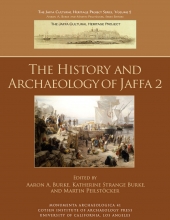Notes
The topical bibliography presented here has been collected as part of a longstanding effort to bring together disparate sources for the study of Jaffa from its earliest habitation through the late Ottoman and Mandate periods. Given the scope of studies concerning Jaffa’s history and archaeology, it is impossible to claim that this bibliography is comprehensive, and it is certainly not exhaustive. It may provide, however, a useful starting point for those dealing with Jaffa or some aspect of Jaffa’s cultural heritage.
This bibliography of nearly 500 works should be viewed as a supplement to the extant bibliographies provided in book-length treatments of Jaffa, of which there are only a few. These include overview literature (cited under the first heading below), the first volume of the History and Archaeology of Jaffa (Peilstöcker and Burke 2011), and a catalog associated with the 2014 exhibit, Jaffa: Tor zum Heiligen Land (Peilstöcker, Schefzyk, and Burke 2013), but also Ruth Kark’s study of late Ottoman Jaffa (Kark 1990) and, finally, the now quite dated monograph by Samuel Tolkowsky (1924), all of which are included below and discussed in the introduction to this volume. Additional treatments and catalogs are less accessible, but their contents have been mined for the references found above. In addition, a number of Hebrew and English dissertations related to Jaffa, which have appeared in recent years, occur under relevant sections.
Efforts have been made to avoid excessive reduplication of references under the primary categories that have been adopted. Nevertheless, on occasion, a reference may appear under more than one heading if it is particularly relevant to two or more topics. Furthermore, only published works appear here, and no in preparation, forthcoming, or in press works are listed here to avoid errors in citations. Because a little more than 15 percent of the literature collected here is in Hebrew, citations of such works feature the most common translations of their titles.
Judicious consultation of this would entail a consultation of multiple categories of the bibliography to provide a complete picture for any given period. The late Ottoman period, for example, can only be fully grasped by examining §1. Historical, Archaeological, and Environmental Overviews, various stages in the early exploration of Jaffa during the nineteenth and twentieth centuries (§2. Early Encounters), in addition to the bibliography on §4.4. Mamluk and Ottoman Jaffa but also §4.5. British Mandate Jaffa, 1936–1947, when many Ottoman monuments and many late Ottoman traditions persisted in the Old City.
Given the recognition of Abu Kabir’s intimate relationship with Jaffa, as one of its burial grounds during the Roman and Byzantine periods, it has also been included in this bibliography (§7. Abu Kabir). The more extensive literature on Tel Aviv, however, is omitted given the scope and ancillary nature of this literature to understanding Jaffa, primarily before the British Mandate.
Files that can be imported into reference management systems can be downloaded below.
Item record
Reuse
Burke, Aaron A., Katherine Strange Burke, and Martin Peilstöcker 2017. "Appendix 3: Bibliography for Jaffa, Abu Kabir, and Environs" for The History and Archaeology of Jaffa 2. Version 1. Cotsen Institute of Archaeology Press. https://doi.org/10.25346/S6/YDGENR
